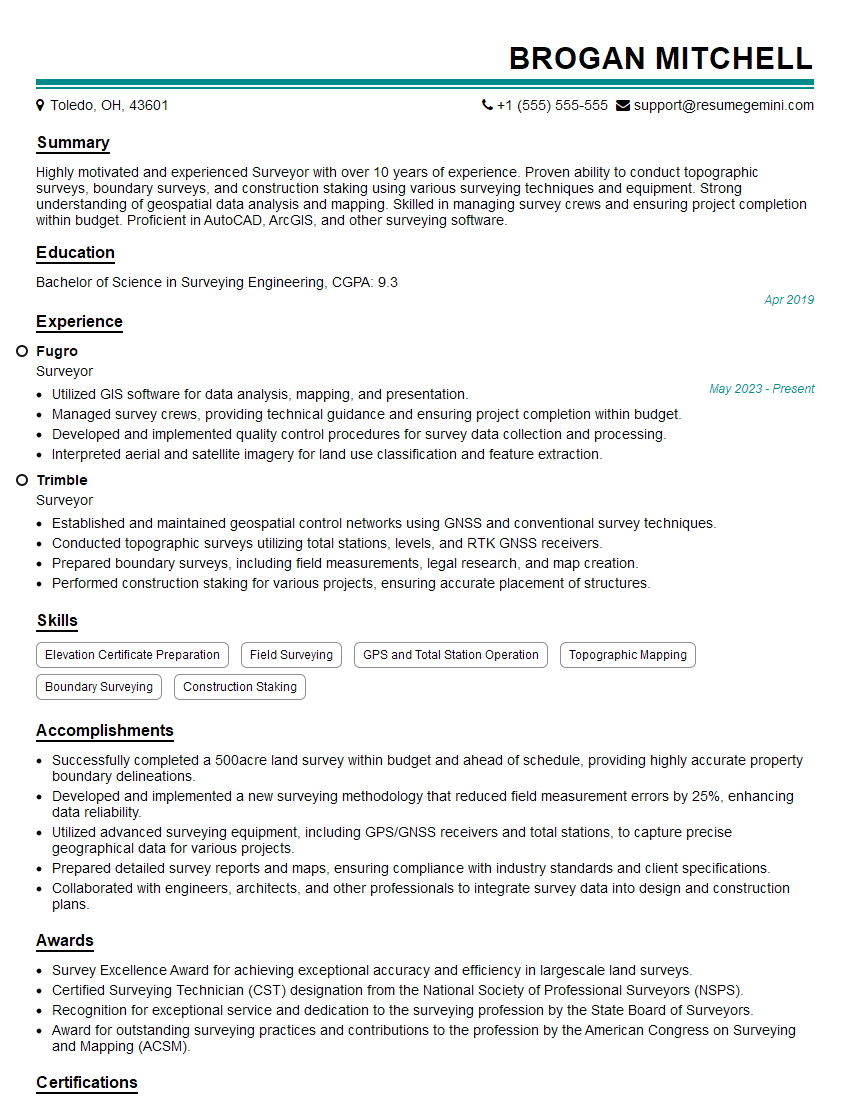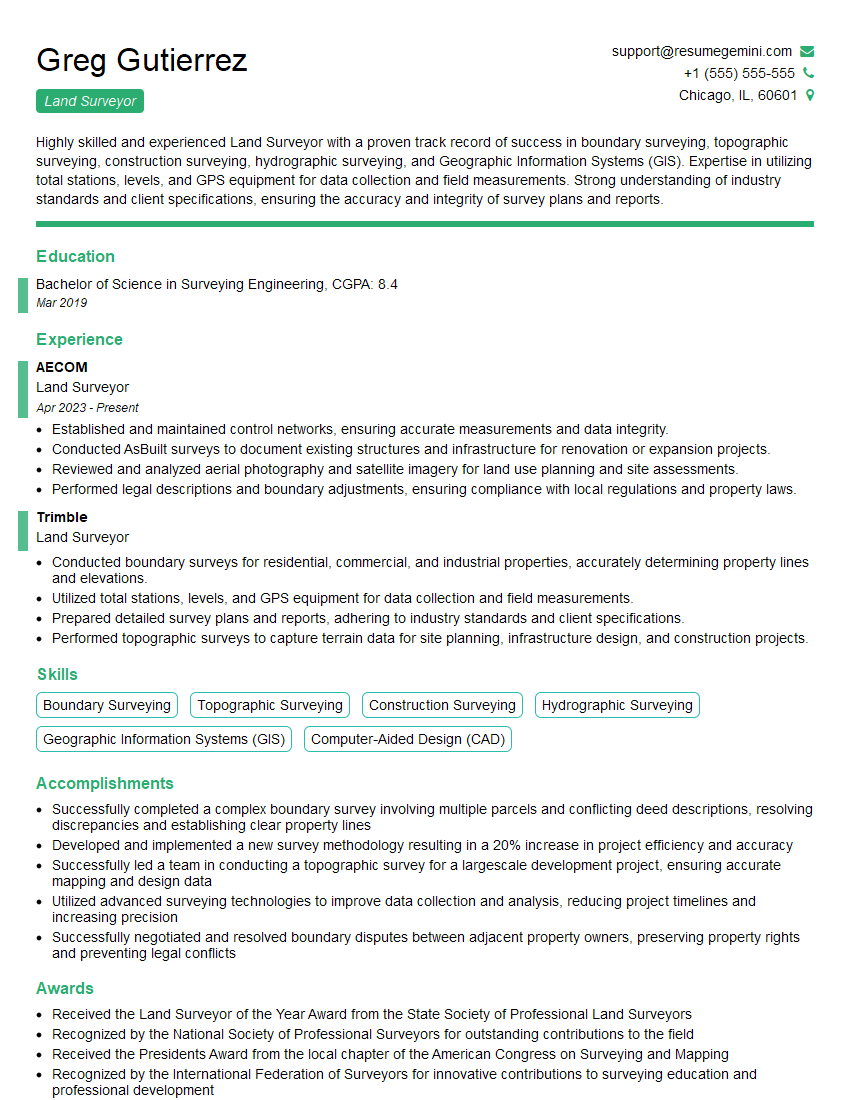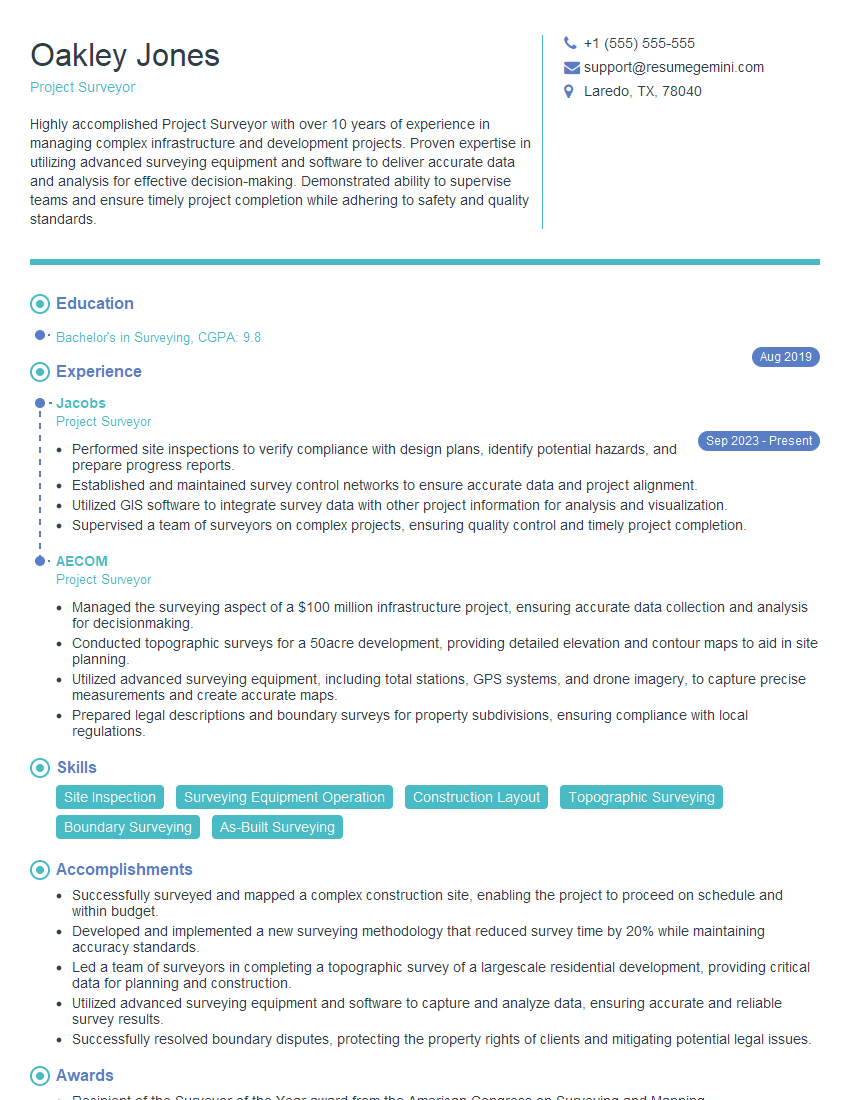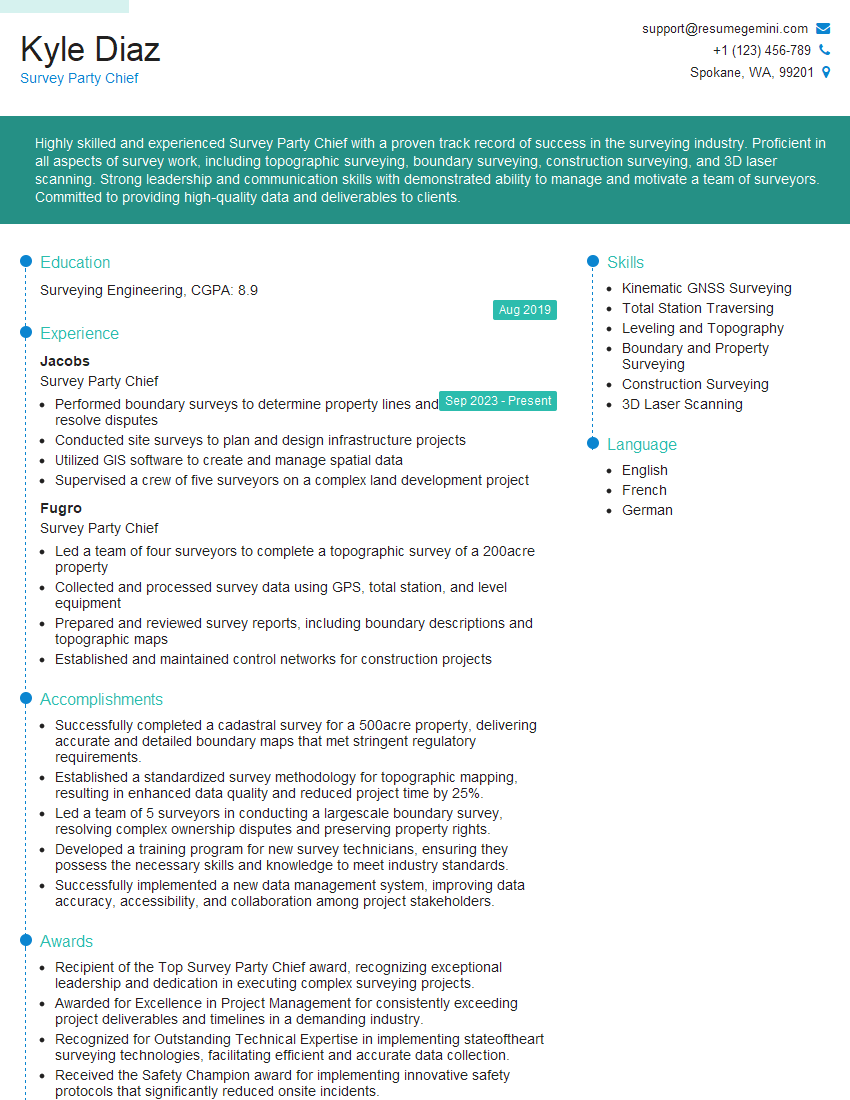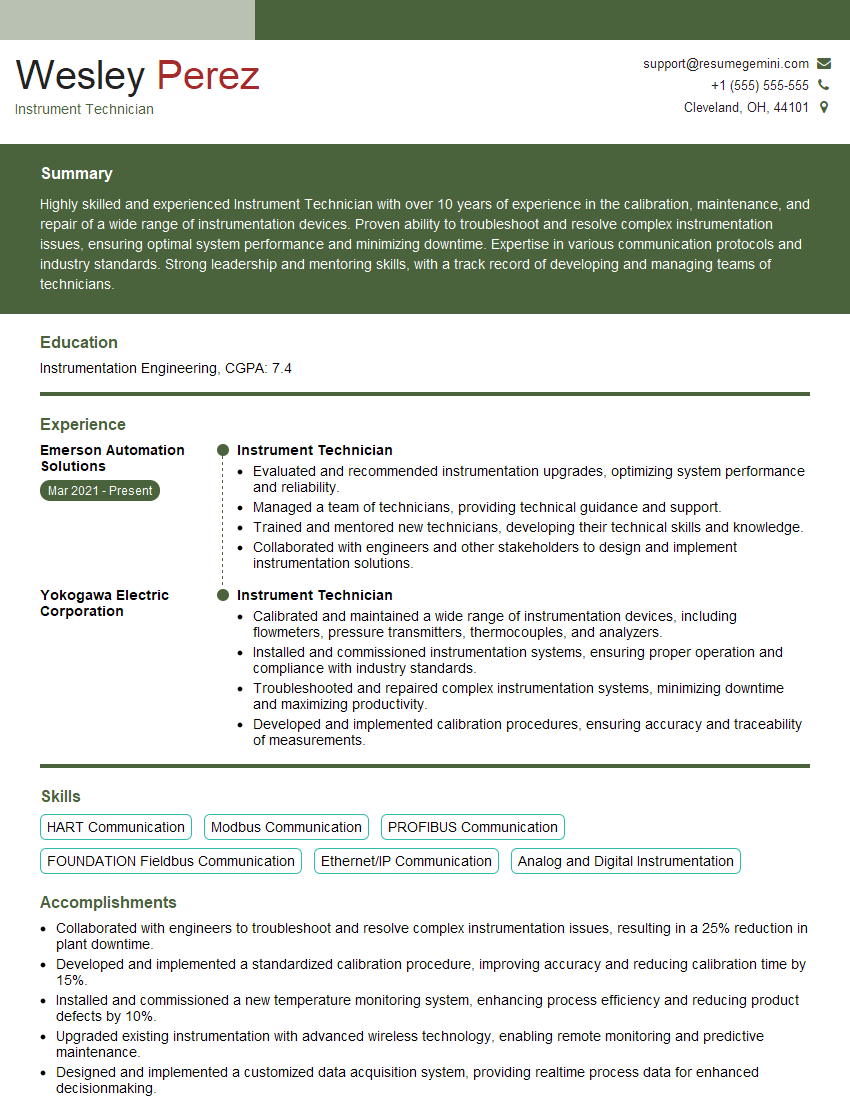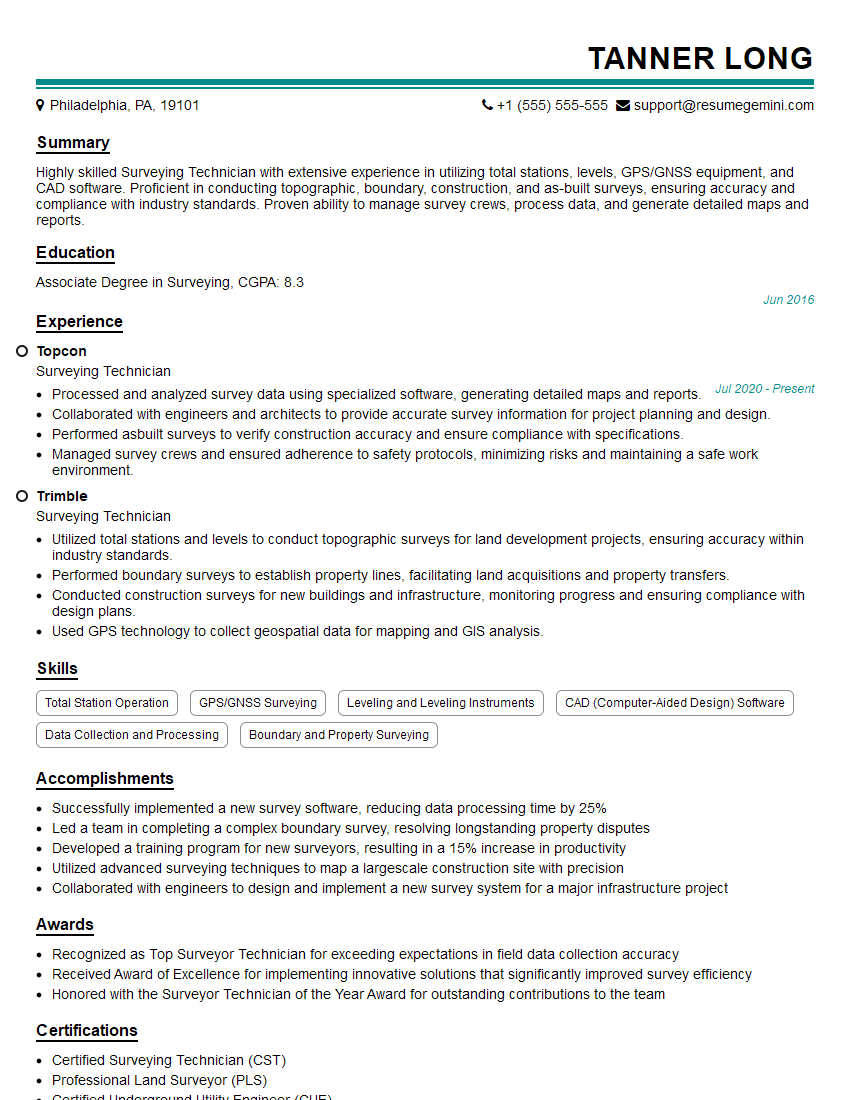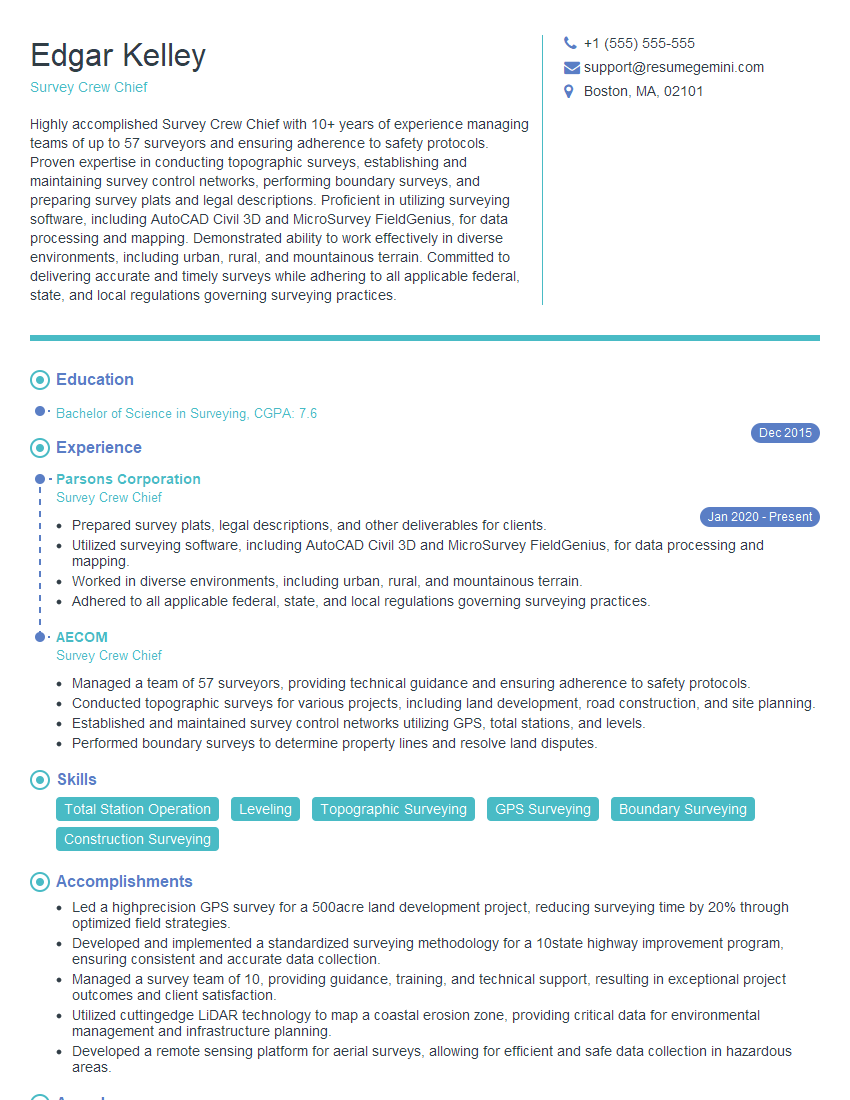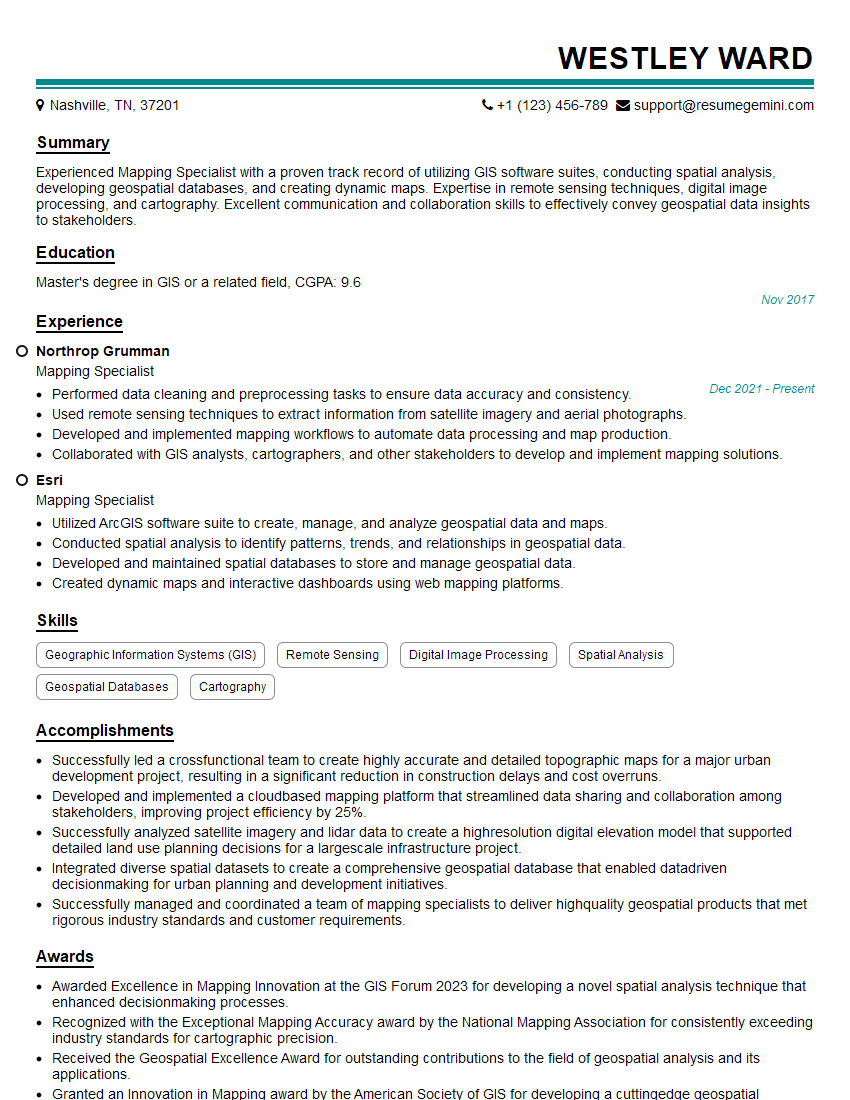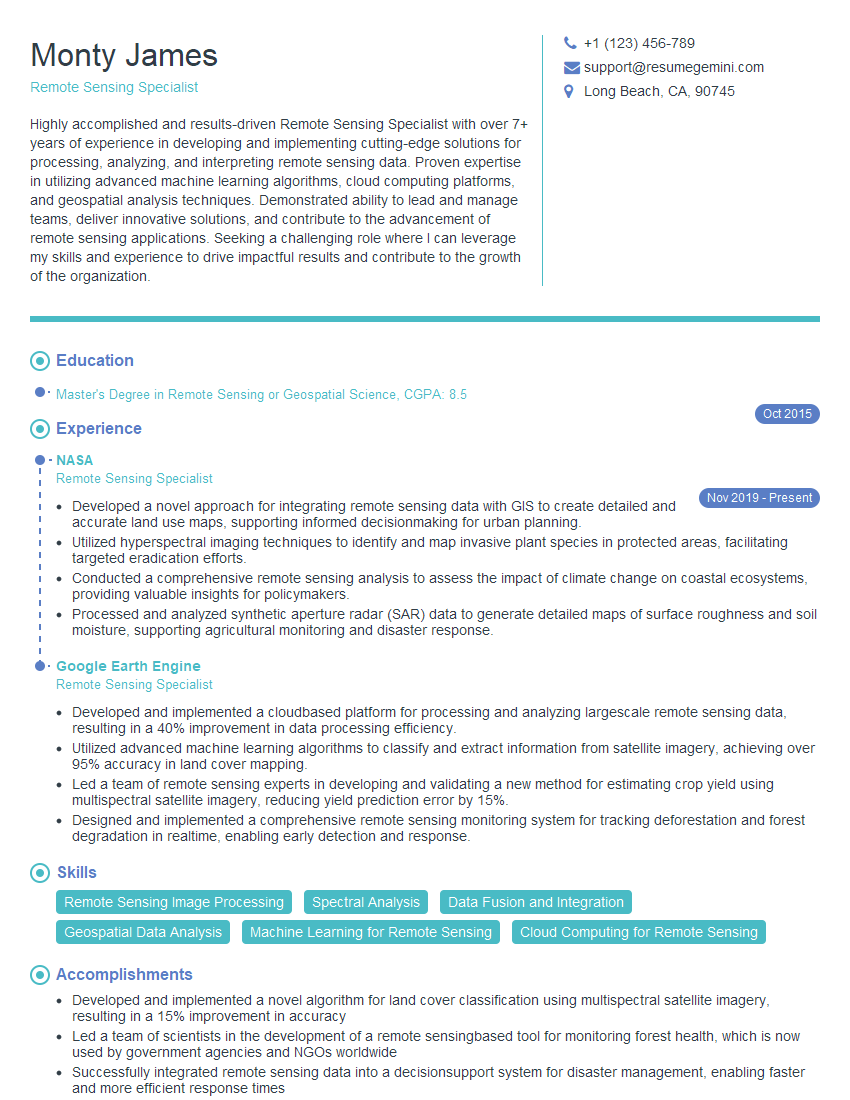Every successful interview starts with knowing what to expect. In this blog, we’ll take you through the top Experienced in using total stations for topographic surveys interview questions, breaking them down with expert tips to help you deliver impactful answers. Step into your next interview fully prepared and ready to succeed.
Questions Asked in Experienced in using total stations for topographic surveys Interview
Q 1. Explain the principle of operation of a total station.
A total station is an electronic surveying instrument that combines the functions of an electronic theodolite, an electronic distance meter (EDM), and an onboard computer. Its primary principle of operation rests on precisely measuring angles (horizontal and vertical) and distances. The EDM uses either infrared or laser technology to measure the distance to a target by emitting a signal and measuring the time it takes to return. Simultaneously, the theodolite measures the horizontal and vertical angles to that same target. The onboard computer processes this data, calculating coordinates and other relevant information. Think of it as a highly sophisticated, automated level and transit combined, with the added benefit of computing everything for you.
Essentially, the total station determines the three-dimensional position of a point by accurately measuring its distance and angles relative to the instrument’s known position. This data forms the backbone of accurate topographic surveys.
Q 2. Describe the different types of total stations and their applications.
Total stations vary in features and capabilities. They can broadly be categorized based on accuracy, automation level, and added functionalities. Here are some examples:
- Conventional Total Stations: These are generally less automated, requiring manual data entry and processing. They’re often suitable for less demanding tasks like simpler boundary surveys.
- Robotic Total Stations: These are highly automated. They use a prism attached to the target and track it automatically, eliminating the need for a separate person to keep the prism aligned. This boosts efficiency, particularly in challenging terrain. I’ve extensively used robotic total stations on large infrastructure projects, significantly improving our speed and accuracy.
- Motorized Total Stations: These offer automated pointing and tracking capabilities, similar to robotic systems, but may require manual input for some functions. This category offers a balance between automation and cost-effectiveness.
- GNSS-Integrated Total Stations: These combine the precise angle and distance measurements of a total station with the global positioning capabilities of GNSS (Global Navigation Satellite Systems), delivering highly accurate geospatial data. I’ve found this integration invaluable for large-scale mapping projects where precise georeferencing is crucial.
The application of a particular type of total station depends heavily on the project’s needs. For instance, a robotic total station is ideal for steep, difficult-to-access areas, while a conventional one might suffice for a small-scale site survey. The key is selecting an instrument whose features align with the project’s requirements and budget.
Q 3. How do you perform instrument setup and calibration?
Instrument setup and calibration are critical for accurate measurements. Proper setup involves centering the total station over a known point, leveling it precisely, and orienting it to a known direction. I usually follow these steps:
- Centering: I use a plumb bob or optical plummet to ensure the instrument is directly over the survey point.
- Leveling: I use the instrument’s built-in levels to achieve precise leveling. This is usually done using the leveling screws, ensuring the bubble in the circular level is centered before using the more precise plate levels for finer adjustments.
- Orienting: I orient the instrument using a known direction, such as a previously established baseline or by using GNSS positioning. This ensures that all subsequent measurements are referenced to a consistent coordinate system.
Calibration involves regularly checking and adjusting the instrument’s internal components. This includes verifying the EDM’s accuracy by measuring a known distance and confirming the angular measurements against known points. Most modern total stations perform internal calibrations automatically, but regular checks using known distances and angles are still essential to ensure high-quality data.
Regular maintenance, such as cleaning the instrument’s optical components, is also crucial for preventing errors.
Q 4. Explain the process of traversing using a total station.
Traversing with a total station is a widely used surveying technique for establishing control points and determining the positions of points along a line. It involves a series of interconnected lines, with angles and distances measured between each station. Let’s break down the process:
- Establish a Base Line: Begin by accurately measuring a baseline between two known points. This forms the foundation for the traverse.
- Set up the Instrument: Set up the total station at one end of the baseline.
- Measure Angles and Distances: Measure the horizontal and vertical angles, as well as the distance, to the next station in the traverse.
- Proceed to the Next Station: Move the total station to the newly observed station. Repeat the angle and distance measurements to the next point.
- Close the Traverse: Continue this process until you reach the final point in the traverse. It is often closed by returning to the original point or connecting to another known point. The final coordinates should match the starting coordinates to achieve a closed traverse.
- Data Processing: Use surveying software to process the collected data, performing coordinate calculations, error detection, and analysis. This will help with adjustment and error propagation.
Traversing provides a robust way to establish a network of control points, crucial for mapping larger areas and complex projects. I have used traversing extensively during road design projects where accurate control points were critical.
Q 5. How do you perform level runs with a total station?
While total stations are primarily used for 3D positioning, they can also be used for leveling. It’s not the most efficient method, but it’s certainly possible. It’s important to note that dedicated levels are generally preferred for precise leveling.
Using a total station for level runs typically involves:
- Setup and Leveling: Set up and accurately level the total station at a known benchmark.
- Instrument Height Measurement: Accurately measure the height of the instrument above the benchmark.
- Sightings: Take sight readings to each point along the level run, noting the vertical angle and the distance.
- Height Calculation: Use the instrument height, vertical angle, and distance to calculate the height of each point using trigonometry or the total station’s internal computation features. Essentially, you are calculating the vertical distance between the instrument and each target point.
- Reduced Level Calculation: Subtract the height of each point from the benchmark’s height to get the reduced level (elevation) for each point.
This method is suitable for smaller-scale leveling tasks or situations where a dedicated level is unavailable. However, for large-scale leveling projects, a dedicated level remains the preferred method due to its inherent accuracy and efficiency.
Q 6. What are the common sources of errors in total station measurements, and how do you mitigate them?
Several sources of error can affect total station measurements. Identifying and mitigating these errors is crucial for achieving high accuracy. Common sources include:
- Instrumental Errors: These include misalignment of the instrument, errors in the EDM, and atmospheric effects (temperature, pressure, humidity) on the EDM readings. Regular calibration and atmospheric corrections help mitigate these.
- Target-Related Errors: Incorrect centering of the target or using a poor-quality target can lead to significant errors. Always use stable and properly centered targets.
- Observer Errors: Mistakes in reading angles or distances, incorrect instrument setup, or improper data recording are human errors that contribute to inaccuracy. Systematic quality checks are necessary to minimise this type of error.
- Environmental Errors: Temperature fluctuations, wind, and refraction can all affect measurements. Employing appropriate procedures, including considering atmospheric refraction, will help lessen these.
- Reflection Errors: When using a prism, poor reflectivity can lead to errors, particularly in low-light conditions. Ensure you’re using high quality prisms that are clean and appropriately positioned.
Mitigation strategies involve using high-quality equipment, employing proper surveying techniques, performing regular calibration, implementing rigorous quality control procedures, and applying environmental corrections where appropriate.
For example, on one project I experienced issues with refraction in high heat conditions. By implementing atmospheric corrections using a meteorological sensor and checking the accuracy of the measurement using redundant measurements and checking against other survey data, we improved the accuracy significantly.
Q 7. Describe your experience with different types of surveying targets.
My experience encompasses a wide range of surveying targets, each suited to different circumstances:
- Prisms: These are the most common targets used with total stations, offering high reflectivity and precision. I’ve used various types, including single prisms, triple prisms, and mini prisms, each chosen based on the distance to the target and environmental conditions. Triple prisms are beneficial over longer distances, allowing for more precise measurement of the signal.
- Reflective Targets: These are simpler, less expensive targets, suitable for shorter distances. They are useful for situations where prism mounting might be difficult or impractical.
- Circular Targets: These are particularly helpful when measuring points from a distance or when the target needs to be visible from multiple directions. This is particularly true when establishing control.
- Targets with Code: Some targets integrate identification codes to aid in automatic data recording and eliminate potential errors during data processing.
The selection of the appropriate target is critical to ensuring accurate and efficient data acquisition. For instance, when surveying in a densely forested area, I would opt for mini prisms due to their size and ease of use in restricted areas. In contrast, for long-distance measurements across open terrain, I would utilize a triple prism for its increased reflectivity.
Q 8. How do you handle atmospheric corrections in total station measurements?
Atmospheric conditions like temperature, pressure, and humidity significantly affect the speed of light, influencing the accuracy of total station measurements. To compensate, we apply atmospheric corrections. This involves using a meteorological instrument (often built into the total station) to measure these parameters. The total station then uses these readings and a formula (often based on the modified formula) to calculate a correction factor that’s applied to the measured distance. Think of it like adjusting for wind resistance when measuring a long distance – we need to account for the external factors affecting our measurement.
For example, if the temperature is higher than the instrument’s assumed standard, the light will travel slightly faster, resulting in an underestimated distance. The correction factor adjusts for this discrepancy. Failing to correct for atmospheric conditions can lead to significant errors, especially over longer distances. I always double-check these readings before commencing a survey, especially in extreme weather conditions.
Q 9. Explain the concept of coordinate systems used in surveying and how they relate to total station data.
Coordinate systems are fundamental in surveying. They define the location of points on the earth’s surface using a set of numbers (coordinates). Total stations record measurements in a specific coordinate system, allowing us to precisely locate points relative to each other and a known reference point.
- Geographic Coordinate System (GCS): Uses latitude and longitude, based on the Earth’s spheroid. It’s great for showing positions on maps but isn’t ideal for local surveying calculations.
- Projected Coordinate System (PCS): Projects the Earth’s curved surface onto a flat plane. This is essential for local surveying projects as it transforms the spherical coordinates into planar coordinates (e.g., x, y, z), which are directly used by total stations. Common examples include UTM (Universal Transverse Mercator) and State Plane Coordinate Systems.
The total station is typically set up in a known coordinate system, and all subsequent measurements are referenced to that system. During data processing, we often transform coordinates between different systems to integrate data from various sources.
For instance, I recently worked on a project where the client provided boundary coordinates in a State Plane Coordinate System. I ensured my total station was set up using the same system to ensure seamless data integration and prevent coordinate mismatches.
Q 10. How do you perform data processing and calculations after collecting total station data?
Data processing after collecting total station data involves several crucial steps. This is where raw measurements are transformed into usable information like coordinates and elevations.
- Data Download: Download the raw data from the total station to a computer using a suitable software.
- Coordinate Transformation: If needed, transform the data from the instrument’s coordinate system to a project-specific coordinate system (e.g., converting from instrument coordinates to UTM).
- Data Editing: Check and edit the data for any errors. This includes identifying and removing any erroneous points or measurements caused by obstructions or instrument malfunction.
- Calculations and Computations: Perform calculations such as computing coordinates of points, creating contours, and determining volumes based on the processed data. This often includes applying corrections for instrument height and target height.
- Quality Control: Thoroughly check the processed data for accuracy and consistency using various methods.
- Report Generation: Generate reports and drawings based on the processed data for the client.
For example, to calculate the volume of earthworks, I’d use the processed coordinates and elevations to generate a digital terrain model (DTM) and subsequently calculate the volume using software tools.
Q 11. What software are you familiar with for processing total station data?
I’m proficient in several software packages used for processing total station data, including:
- AutoCAD Civil 3D: A comprehensive software package that allows for robust data processing, CAD drawing creation, and surface modeling.
- Trimble Business Center (TBC): Powerful software specializing in processing data from Trimble total stations. It offers advanced functionalities for data processing, analysis, and reporting.
- MicroStation with Bentley InRoads: This combination is a common choice in infrastructure projects. MicroStation provides the CAD environment, while InRoads facilitates processing and design within that environment.
- LSS (Least Squares Software): Often used for advanced adjustment of survey networks. It is useful to enhance the accuracy of the data processing results.
My choice of software depends on the project’s requirements and the client’s preferences. I’m also adaptable and can quickly learn new software if needed.
Q 12. Describe your experience working with different data formats used in surveying.
I have extensive experience working with various data formats commonly used in surveying, including:
- ASCII/Text Files (.txt, .dat): These are simple text-based formats suitable for exchanging data between different software packages. They’re often used for simpler surveys.
- DXF (Drawing Exchange Format): A widely used CAD format, useful for integrating survey data into CAD drawings.
- LandXML: A standard XML-based format developed specifically for exchanging land surveying data between different software programs.
- Proprietary Formats: Specific formats used by manufacturers of total stations (e.g., Trimble’s .dat, Leica’s .gsi). These formats usually contain additional metadata specific to the instruments used.
I understand the nuances of each format and can efficiently convert data between them as needed. This ensures compatibility and smooth workflow between different software and teams.
Q 13. How do you ensure the accuracy and precision of your total station measurements?
Ensuring accuracy and precision in total station measurements involves a multi-faceted approach:
- Instrument Calibration: Regular calibration of the total station is critical. This involves checking the instrument’s accuracy in measuring distances and angles through rigorous testing.
- Proper Setup: Precise instrument setup is paramount. I carefully level the instrument and ensure it’s stable to minimize errors. I also employ proper centering techniques to avoid offsets.
- Target Selection: Selecting appropriate targets that are stable, easily visible, and reflect the laser accurately is essential.
- Atmospheric Corrections: As previously mentioned, applying accurate atmospheric corrections is crucial for long-distance measurements.
- Multiple Measurements: Taking multiple measurements of each point and averaging the results helps to minimize random errors.
- Data Validation: Rigorous data validation is critical. This involves checking for outliers and inconsistencies in the measurements.
By adhering to these procedures, I can confidently guarantee the quality and reliability of my data. For example, during a recent road alignment survey, I repeated measurements three times for each station, ensuring high precision despite challenging terrain.
Q 14. Describe your experience in performing stakeout using a total station.
Stakeout using a total station involves precisely locating and marking points in the field based on design data. This is crucial in construction and engineering projects.
- Data Preparation: The design data (usually coordinates) is first transferred to the total station’s data collector.
- Instrument Setup: The total station is precisely set up with a known coordinate.
- Stakeout Procedure: Using the total station, I locate the designated points by entering their coordinates. The instrument guides me to the exact location of each point, using either the instrument’s display or robotic functionalities.
- Marking the Points: Once the instrument indicates the location, I mark the point using a stake, paint, or other appropriate marking methods.
- Quality Check: I always perform quality checks to confirm the accuracy of the stakeout. This might involve re-measuring or comparing with nearby surveyed points.
For example, I recently used a total station to stake out the foundation points of a large building. The precision achieved with the total station ensured that the foundation was precisely aligned with the design plans. Any slight error here can lead to significant issues later in the construction process, so accurate stakeout is critical for structural integrity.
Q 15. Explain your understanding of different surveying methods and their suitability for different applications.
Surveying employs various methods, each suited to specific tasks. The choice depends on factors like accuracy requirements, terrain, project scale, and budget.
- Traversing: A series of connected lines where angles and distances are measured to establish the relative positions of points. Ideal for mapping large areas or creating control networks. Think of it like creating a detailed map by walking a carefully measured path, connecting points to create a framework.
- Triangulation: Measuring angles to determine distances and positions. Useful in areas with limited accessibility, like across a wide river. Imagine building a framework using angles instead of directly measuring all distances.
- Trilateration: Measuring distances to determine positions. This works well in open areas where clear sightlines are available. Similar to triangulation but uses measured distances instead of angles.
- Leveling: Determining elevations using a level and staff. Essential for establishing benchmarks and creating contour maps to show changes in elevation across an area. This is like finding out how high or low different points are on the ground.
- Total Station Surveying: A highly precise method combining angle, distance, and elevation measurements, providing comprehensive data. This is the method I specialize in. Think of it as a powerful and versatile all-in-one surveying tool.
For instance, traversing is perfect for mapping a large construction site, while leveling is crucial for road design ensuring proper drainage. Total station surveys are used for detailed building layouts and precise site mapping, offering the highest level of accuracy.
Career Expert Tips:
- Ace those interviews! Prepare effectively by reviewing the Top 50 Most Common Interview Questions on ResumeGemini.
- Navigate your job search with confidence! Explore a wide range of Career Tips on ResumeGemini. Learn about common challenges and recommendations to overcome them.
- Craft the perfect resume! Master the Art of Resume Writing with ResumeGemini’s guide. Showcase your unique qualifications and achievements effectively.
- Don’t miss out on holiday savings! Build your dream resume with ResumeGemini’s ATS optimized templates.
Q 16. How do you deal with obstructions during a survey using a total station?
Obstructions are a common challenge in surveying. My approach involves a combination of techniques depending on the type and severity of the obstruction.
- Reflectorless measurements: Many modern total stations offer reflectorless measurement capabilities, eliminating the need for prisms. This is particularly useful for measuring distances to inaccessible points or through obstructions like dense vegetation.
- Traverse around the obstruction: If possible, I’ll plan the traverse route around the obstruction, ensuring that all points are still accurately connected within the survey network.
- Using multiple setups: For large or complex obstructions, I’ll strategically set up the total station in multiple locations to get clear sightlines to the target points. This involves careful planning to ensure the accuracy of the whole network.
- Reciprocal measurements: In situations where direct measurement is impossible, I’ll employ reciprocal measurements from two different setups to determine the distance and position across the obstruction.
For example, when surveying a building site with a large tree in the way, I might use a combination of reflectorless measurements and traverse around the tree to get accurate data for the site layout. Careful documentation of the methods used is crucial for maintaining the integrity of the data.
Q 17. Describe your experience working with GPS equipment in conjunction with a total station.
GPS and total stations complement each other, providing a robust and accurate surveying solution. GPS provides broad control points, while total stations deliver precise detail.
I have extensive experience in using GPS, typically RTK (Real-Time Kinematic) GPS, in conjunction with total station surveys. This approach is valuable for establishing a geodetic control network for the project. The GPS provides the horizontal and vertical positions of a few key control points, and the total station then accurately measures the positions of all other points relative to those established GPS points. This improves the accuracy and efficiency of the overall survey.
For example, in a large-scale land survey, I might use GPS to establish a few control points across the area, then use a total station to detail the boundaries, features, and topography of the land. The combination minimizes errors and provides a highly accurate representation of the area.
Q 18. How do you manage and store survey data to ensure its integrity and accessibility?
Data management is crucial for ensuring the integrity and accessibility of survey data. My approach involves a multi-layered strategy.
- Field data collection: Data is carefully recorded in the total station’s internal memory and regularly backed up to a secure external device, ideally twice during a long survey day.
- Data processing: Data is processed using industry-standard software, which applies rigorous quality control checks. Any anomalies are investigated thoroughly.
- Data storage: Data is stored using a secure server-based system with version control, ensuring traceability and disaster recovery capabilities. Project files are well-organized using a clear naming convention. Backups are stored on a separate site.
- Data sharing: Secure methods are used to share data with clients and collaborators, respecting confidentiality and data protection policies. Access permissions are appropriately managed.
This approach minimizes risks and keeps the data safe, accessible, and verifiable. It also allows for easy collaboration among team members.
Q 19. Describe your experience with quality control and quality assurance in surveying.
Quality control (QC) and quality assurance (QA) are paramount in surveying. My approach involves a systematic process built around standards and best practices.
- Instrument Calibration: Regular calibration of the total station is vital. This involves checking the accuracy of its internal components and adjusting them to factory specifications. This is performed as part of our pre-survey procedures.
- Data Validation: During data processing, I employ stringent checks for outliers and inconsistencies, using statistical methods to identify and address errors. Software typically has built-in checks. I also perform manual checks in addition to this.
- Field Checks: During the survey, I regularly conduct field checks to ensure measurements are accurate, and I confirm the quality of data during each stage.
- Documentation: Meticulous record-keeping is maintained throughout the survey process, including calibration certificates, field notes, and data processing reports.
For example, I might compare measurements taken from different setups to identify potential errors. Any discrepancies are thoroughly investigated and corrected before proceeding.
Q 20. How do you interpret survey drawings and specifications?
Interpreting survey drawings and specifications is fundamental to my work. I approach this systematically.
- Understanding the Scale: The first step is to understand the scale of the drawing and the units used (e.g., meters, feet).
- Identifying Key Features: I identify key features like benchmarks, boundary lines, existing structures, and proposed works.
- Analyzing Dimensions and Coordinates: I carefully examine dimensions, coordinates, and notations on the drawings to understand the precise location and design of the features.
- Checking for Consistency: I ensure the drawing is consistent with the project specifications and that all the information is accurate and complete.
- Clarification: If anything is unclear or ambiguous, I seek clarification from the client or design team to avoid errors.
For instance, when interpreting a topographic survey for a road construction project, I would carefully examine the contours, spot elevations, and existing features to understand the terrain and plan the road alignment efficiently. Misinterpretations here can cause major project issues and delays.
Q 21. Describe a time you encountered a significant surveying challenge and how you overcame it.
During a large-scale residential development survey, we encountered significant challenges due to extremely dense vegetation and uneven terrain. Many points were obstructed.
Initially, the time constraints seemed insurmountable. However, my team and I developed a strategy that addressed this. We employed a combination of techniques: We used a drone survey to obtain an initial overview of the area and identify key control points. Then, we used a total station with reflectorless technology to measure inaccessible areas. We also used GPS points from a base station setup to supplement the data collected with the total station. Finally, we carefully planned our traverse routes to avoid the worst of the vegetation, minimizing obstructions.
By combining different technologies and careful planning, we successfully completed the survey on time and to the required accuracy. This experience reinforced the importance of adaptability and creative problem-solving in challenging surveying conditions. The combination of drone imagery with the total station data proved to be very effective in creating a reliable and detailed site model.
Q 22. What safety procedures do you follow while operating a total station?
Safety is paramount when operating a total station. My safety procedures begin with a thorough site assessment before commencing any work. This includes identifying potential hazards like uneven terrain, overhead obstructions (power lines, tree branches), and proximity to traffic. I always wear appropriate Personal Protective Equipment (PPE), including safety glasses, hard hat, and high-visibility clothing. Before switching the instrument on, I ensure the area around the total station is clear of obstructions and people. During operation, I maintain a safe distance from moving vehicles and machinery. I regularly check the instrument’s stability and ensure it’s properly leveled to prevent accidental tipping. Furthermore, I communicate clearly with my crew, especially when pointing the instrument or moving equipment, using hand signals and verbal communication to minimize the risk of accidents. Finally, I regularly inspect the equipment for any damage or malfunctions before and after use.
Q 23. How do you ensure the safety of yourself and your crew during surveying operations?
Ensuring crew safety is as critical as my own. We follow a strict safety briefing before each survey, reviewing the site-specific hazards identified during the initial assessment. We establish clear communication protocols, including the use of hand signals and designated safety officers. We utilize warning signs and barriers to cordon off hazardous areas or areas of active surveying. Everyone on the crew is required to wear appropriate PPE, and we conduct regular safety checks throughout the day. For fieldwork involving steep slopes or precarious locations, we employ appropriate fall protection measures such as harnesses and safety lines. I regularly monitor the crew’s performance and address any safety concerns immediately. For example, if a crew member appears tired or distracted, I will take a break to ensure their well-being. This proactive approach significantly minimizes risks and prevents accidents.
Q 24. What is your experience with different types of prisms used with total stations?
My experience encompasses a wide range of prisms, each with its unique applications. I’m proficient with single prisms, ideal for shorter distances and precise measurements; 360° prisms, which offer excellent versatility for multiple sightlines without repositioning, are frequently used. I’ve also worked extensively with mini-prisms, very useful for detailed work in tight spaces or on challenging terrain. Furthermore, I have experience with various pole-mounted prisms and specialized prisms for long-range measurements, such as those with enhanced retro-reflectivity for challenging light conditions. The selection of the prism depends heavily on the survey’s requirements. For instance, a single prism might suffice for a simple site survey, while a 360° prism would be necessary for a more complex project requiring measurements from various directions.
Q 25. Explain your understanding of the limitations of total station measurements.
Total station measurements, while highly accurate, have limitations. Atmospheric conditions such as temperature, pressure, and humidity can affect the refractive index of the air, leading to slight errors in distance measurements. Similarly, instrument misalignment (collimation errors) or improper leveling can introduce systematic errors. The accuracy also degrades with increasing distance to the prism, and obstructions in the sightline will cause significant errors. Reflectorless measurements, while convenient, generally have lower accuracy than those taken with prisms. Finally, the precision of the total station is only as good as the accuracy of its calibration and the skill of the operator. Understanding these limitations allows me to implement appropriate strategies to mitigate errors. For example, I use atmospheric correction models in my data processing to account for atmospheric effects, regularly check instrument calibration, and employ multiple measurements to reduce the impact of random errors.
Q 26. How do you handle data discrepancies or inconsistencies during a survey?
Data discrepancies can arise from various sources, including instrument malfunction, human error, or environmental factors. My approach to handling inconsistencies begins with a careful review of the field notes and raw data. I cross-check measurements, looking for patterns or anomalies. If a discrepancy is identified, I re-measure the affected points, verifying the instrument’s settings and ensuring correct prism placement. If the problem persists, I might investigate potential environmental factors or instrument issues. For significant discrepancies, I would analyze the data statistically, using methods such as least squares adjustment to identify and adjust outliers. If the error cannot be identified, I will document the discrepancy and flag it in my report, noting any potential sources of error and their likely impact on the overall survey accuracy. Documentation is key; thorough field notes are crucial in tracing the source of discrepancies. A thorough understanding of the limitations of a total station makes it easier to interpret inconsistencies.
Q 27. Describe your experience using robotic total stations.
I have extensive experience using robotic total stations, which have significantly improved efficiency and productivity. I am proficient in setting up and operating both the total station and the remote control unit (RCU). The robotic capabilities allow for one-person operation, reducing fieldwork time and eliminating the need for a rod person in many applications. I’m comfortable using various robotic functions, such as automatic target recognition (ATR) and lock-on, even under challenging conditions. I’m familiar with the various data transfer methods, which allows for more streamlined data processing. For example, I have used robotic total stations in complex site surveys with many points to measure, greatly improving efficiency and reducing the labor cost. However, I also understand the limitations, especially in environments with significant obstructions or poor atmospheric conditions, where ATR might not function reliably. The ability to work efficiently with these technologies improves workflow and project delivery time.
Q 28. What are your strengths and weaknesses when using a total station for topographic surveys?
My strengths lie in my thorough understanding of total station operation, my proficiency in handling various prism types, and my ability to troubleshoot and resolve measurement issues quickly and efficiently. My experience with robotic total stations, and my attention to detail in data processing are additional strengths. I’m also adept at working in challenging environments and maintaining safety standards. However, one area I’m continually seeking to improve is my proficiency in advanced data processing techniques. While I’m competent with standard adjustments and error analysis, I’m keen to further develop my skills in more sophisticated data modeling and analysis methods. I’m actively seeking opportunities to learn more about advanced software and techniques to continuously enhance my skill set and contribute to improved efficiency and accuracy in my work. Continuous professional development ensures I remain current in this evolving field.
Key Topics to Learn for Experienced in using Total Stations for Topographic Surveys Interview
- Total Station Operation and Setup: Understanding instrument components, proper leveling techniques, and accurate centering procedures. This includes knowledge of different types of total stations and their capabilities.
- Data Collection Methods: Mastering techniques for various survey tasks, such as traversing, detail surveys, and setting out points. This includes understanding different measurement modes (e.g., distance, angle, coordinates).
- Data Processing and Analysis: Proficiency in using surveying software to process raw data, perform calculations (e.g., coordinates, areas, volumes), and generate accurate topographic maps and drawings.
- Error Detection and Correction: Identifying and correcting common sources of error in total station measurements, including instrumental, observational, and environmental errors. Understanding precision and accuracy in surveying.
- Coordinate Systems and Projections: Working knowledge of different coordinate systems (e.g., UTM, State Plane) and map projections, and their implications on survey data.
- Health and Safety Procedures: Understanding and adhering to safety regulations and procedures when operating total stations in various field environments. This includes working at heights and near hazards.
- Legal Aspects and Surveying Standards: Familiarity with relevant surveying standards and regulations, ensuring legal compliance in data acquisition and reporting.
- Practical Applications: Ability to discuss real-world applications of topographic surveys using total stations, such as construction layout, land development, and infrastructure projects. Be prepared to offer specific examples from your experience.
Next Steps
Mastering the use of total stations for topographic surveys is crucial for career advancement in the surveying and engineering fields, opening doors to more challenging and rewarding opportunities. A well-crafted resume is essential to showcase your expertise and secure your ideal role. Building an ATS-friendly resume significantly increases your chances of getting noticed by recruiters and landing interviews. ResumeGemini is a trusted resource that can help you build a professional and impactful resume tailored to highlight your skills and experience in this specific area. Examples of resumes tailored to “Experienced in using total stations for topographic surveys” are available to help you get started.
Explore more articles
Users Rating of Our Blogs
Share Your Experience
We value your feedback! Please rate our content and share your thoughts (optional).
What Readers Say About Our Blog
Hi, I’m Jay, we have a few potential clients that are interested in your services, thought you might be a good fit. I’d love to talk about the details, when do you have time to talk?
Best,
Jay
Founder | CEO
